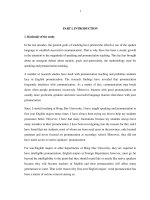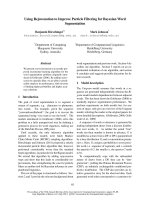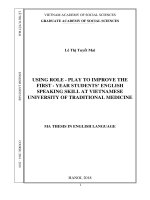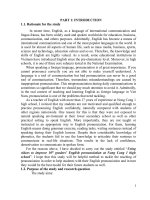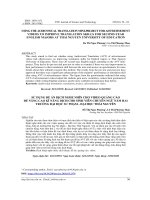USING VIDEOS TO IMPROVE EFL VIETNAMESE LEARNER’S ENGLISH PRONUNCIATION
Bạn đang xem bản rút gọn của tài liệu. Xem và tải ngay bản đầy đủ của tài liệu tại đây (1.03 MB, 92 trang )
1
MINISTRY OF EDUCATION AND TRAINING
VINH UNIVERSITY
TRẦ N NGUYỄN NHƯ QUỲNH
USING VIDEOS TO IMPROVE
EFL VIETNAMESE LEARNER’S ENGLISH
PRONUNCIATION
Major: Teaching English to Speakers of Other Languages (TESOL)
Code: 60140111
MASTER’S THESIS IN EDUCATION
SUPERVISOR:
Nguyen Gia Viet, Ph.D.
Nghệ An, 2017
2
STATEMENT OF AUTHORSHIP
I herein declare that the thesis is my own work and that it has not been submitted
for any other purposes before.
Works of others that are used in the thesis are properly cited and acknowledged.
Tran Nguyen Nhu Quynh
3
ACKNOWLEDGMENTS
I would like to take this opportunity to express my sincere thanks to many
people, from whom I have received valuable contributions for the completion of
this work.
First of all, I would like to express my deepest thanks to my beloved
supervisor, Mr. Nguyen Gia Viet, Ph.D for his valuable support, guidance and
timely, encouragement while I was doing this research. Without his guidance,
comment, and suggestions during all phases of the work, my thesis would still
be far from completed.
Secondly, I would also like to express my gratitude to all lecturers and staff
of the Department of Foreign Languages, Vinh University who supply me with
the good conditions to conduct this thesis and finish this TESOL M.A cohort.
In addition, my special thanks also go to the non-English major students of
grade 11th in Le Quy Don High School for their willingness to complete the
survey questionnaire. Without their help, this project could not been a success.
Last but not least, my warmest thanks go to my beloved family, my colleagues,
my friends for their kindness, helpful supports and useful encouragements.
4
ABSTRACT
In learning English, Pronunciation is an important skill because a word
being pronounced incorrectly or wrong intonation may lead to misunderstanding
from listeners. Most of EFL Vietnamese learners have difficulties in
pronouncing the words correctly in English. The National University Entrance
Exam delivered annually does not test oral and aural competencies of the
prospective English language teachers. As they do not expected to have these
skills, students automatically do not focus on listening comprehension and
pronunciation aspects of the target language, which leads to lose one of the
components of an effective communication. In order to eradicate this problem,
this study aims to investigate the audiovisual method which means using videos
to improve EFF Vietnamese learners’ English pronunciation. The data were
collected mainly through survey questionnaires, interview and tests.
Questionnaires are administered to 60 participants of the two non-major English
classes whose ages 17, and then analyzed by means of descriptive statistics.
These learners were pretested through a number of pre-designed words which be
rated in terms of pronunciation accuracy. Based on the results of the pre-test,
two groups, one as the experimental group and the other as control group, were
formed. Then, traditional method (drill) will be used for the control group in
pronunciation practice. Meanwhile, videos will be used to get the experiment
group practice. After three months, the two groups were posttested through
similar in format and material to the pre-test. The score of the participants
demonstrated that experimental group outperformed the control group in terms
5
of the average accuracy gains. Finally, it was concluded that videos can lead to
higher accuracy in improving EFL Vietnamese’s English Pronunciation.
TABLE OF CONTENTS
ACKNOWLEDGMENTS
ABSTRACT
LIST OF TABLES
CHAPTER ONE INTRODUCTION
1 Rationale
2Research Questions
3 The Objective of the study
4 Significance of the study
5 Scope of the Study
6Methodology
CHAPTER TWO LITERATURE REVIEW3
A. The Nature of Pronunciation
1) The definition of Pronunciation3
2) Definition of consonant
2.1 Place of Articulation
2.2 Manner of Articulation
2.3 Manners of Interference
3) Consonant in English Phonology
3.1 English sound class
3.2 Consonants
4) Teaching Pronunciation
4.1 The objective of teaching pronunciation
6
4.2 The problems of teaching pronunciation for EFL Vietnamese learners
4.3 Methods and techniques of teching pronunciation
B. The Nature of Audio-visual aids
1 Kinds of Audio-visual aids
2 The Advantages of using Audio-visual aids
CHAPTER THREE METHODOLODY
A. The setting and the subject of the Research
1. Time and place of the Research
2. The subject of the Research
B. Action Research
1. Definition of Action Research
2. The steps in Action Research
3. The procedure of Action Research
3.1 Indentify a problem area...................................................................................
3.2 Planing the action.............................................................................................
C. Method of Research ..........................................................................................
D. Research Instruments ........................................................................................
1. Pretest................................................................................................................
2. Questionnaire....................................................................................................
3. Treatment...........................................................................................................
4. Posttest..............................................................................................................
E. Data Collection Procedure.................................................................................
F. Data Analysis......................................................................................................
CHAPTER FOUR FINDINGS AND DISCUSSION
A Research Findings................................................................................................
Cycle 1....................................................................................................................
7
1)Questionnaire A.................................................................................................
2)Interview...........................................................................................................
3)Pre-test..............................................................................................................
4)Planning............................................................................................................
5)Action ...............................................................................................................
6)Observation.......................................................................................................
7)Reflection..........................................................................................................
Cycle 2....................................................................................................................
1) Revised Plan.......................................................................................................
2) Action.................................................................................................................
3) Posttest...............................................................................................................
4) Questionnaire B..................................................................................................
5) Observation........................................................................................................
6) Reflection...........................................................................................................
7) Interview............................................................................................................
B. Discussion..........................................................................................................
1) Videos are able to improve Students’ pronunciation ability..............................
2) Videos are able to improve Students’ perception...............................................
C. Hypothesis testing...............................................................................................
CHAPTER FIVE CONCLUSION..........................................................................
A. Conclusion.........................................................................................................
B. Implication.........................................................................................................
C. Suggestion.........................................................................................................
1) For the teachers..................................................................................................
2) For the institutions.............................................................................................
3) For other researchers..........................................................................................
REFERENCES.......................................................................................................
8
APPENDIX A PRETEST.......................................................................................
APPENDIX B POSTTEST....................................................................................
APPENDIX C DATA COLLECTION FROM PRETEST AND POSTTEST.......
APPENDIX D THE CYCLE1 TEST.....................................................................
APPENDIX E QUESTIONNAIRE A....................................................................
APPENDIX F QUESTIONNAIRE B....................................................................
APPENDIX G ENGLISH PHONETIC SYMBOLS.............................................
9
CHAPTER ONE: INTRODUCTION
1 Rationale
English has been accepted as the dominant means of communication, both
written and spoken in most of the world. And because of the internet, the world
becomes smaller and smaller so English learning is also every important to
Vietnamese learners. During daily communications, we often find some
misunderstandings being caused by inappropriate pronunciation. Sometimes
such mispronunciation is significant and we should pay close attention to the
problem. I decided I would try to tackle the teaching of pronunciation in order to
help my students with their English pronunciation and in turn they would be the
best model for their future students as well.
According to A.G. Gimson “All language are spoken and begun with ears.
Once a known professor notes that at speaking language a person should know
exactly one hundred percent of its phonetics, ninety percent of its grammar and
ten percent of the vocabulary may be sufficient” It seems obvious to me that
phonetics constitutes the basic of all other aspects of language. The students
should first of all learn to hear the sounds accurately and listen to them closely
and carefully. The more and hear the differences between the various sound of
English language, the better they will articulate them. To this end, students
should undergo ear-training and constant listening to English native speakers or
some equally good models. Then they should imitate they should heard, using
their background knowledge to make the proper adjustment of their speech
organs to reproduce the sound correctly. Wrong practice does not only waste
time and effort but also creative had habits, which will be extremely difficult to
eliminate.
10
When speaking a foreign language, say English, pronunciation is of great
importance. If you cannot pronounce correctly you are not able to make yourself
understood. A language is a tool of communication but bad pronunciation can
never be a good tool of communication.
For the reasons above, I have decided to do this research named “ Using
Videos to Improve EFL Vietnamese Learner’s English Pronunciation”. I hope
that this study will be helpful for Vietnamese teachers and students in some
ways to find appropriate approaches to help students improve their
pronunciation.
2 Research questions
1. Does the use of videos help students improve English pronunciation?
2. What perceptions do students have about using videos to help them improve
pronunciation in English classes?
3 The Objectives of the Study
For the reasons mentioned above, the study aims of this thesis to examine
whether or not the audiovisual (videos) method can improve English
pronunciation ability of EFL Vietnamese Learners and to identify what students’
perceptions are when videos are used as a teaching learning media in
pronunciation practice.
4 Significance of the Study
This study is significant in many ways. Firstly, if the results are positive, this can
encourage English teachers to use audio visual in teaching English
pronunciation. Secondly, EFL Vietnamese learners are easy to get more
experience or use videos as an effective way to improve English pronunciation.
Next, it also helps EFL Vietnamese learners to learn English pronunciation
easily or ensure that audio visual can be interesting in teaching English
pronunciation.
11
5 Scope of the study
This research is focused on the effectiveness of using audio visual (videos) to
develop EFL Vietnamese Learner’s English pronunciation. The researcher
wants to make an effort to improve Vietnamese EFL Learners’ six final
consonants (/s/, /z/, /l/, /ð/, /f/, /v/). The researcher chose 60 graded 11 th
students to prove this study. However, this research still has limitation which
is not focused on all ages and regions in Vietnam. It also estimated students’
English pronunciation level by final consonants.
The pronunciation standard used is American standard.
6 Methodology
1. Participants
The participants of this study come from two classes of 11 th graded students
-
from Le Quy Don High School. One class will be experiment group and the
other is control group.
2. The research instruments.
The main data collection instruments are tests and a follow-up questionnaire.
This research will be carried out using an action research design. Two classes
will be chosen to participate in the study: one is the control group and the other
is the experimental (treatment) group. In the first cycle, both groups will be
given a pronunciation test and a questionnaire. In this first test, the students will
be asked to say a number of pre-designed sentences and words and be rated in
terms of pronunciation accuracy. Then, the researcher will use the
questionnaire’s result to make a plan for the students. For a period of three
months, the traditional method (drill) will be used to get the experimental group
practice. Meanwhile, videos will be used to get the experimental group practice
pronunciation. The videos will be only taken from the website “youtube.com”.
After the period, a post test, which is similar in format and materials used to the
pre-test, will be conducted with both groups. The results of the tests will be
12
compared and analyzed to bring about findings for research question 1.
Following the post test, a follow- questionnaire will be distributed to the
experimental group, to investigate students’ experiences and perceptions of
using videos for pronunciation learning in English classes. This followquestionnaire will continue findings for research question 2. The interviews in
this research would also use to support to answer the question 2.
13
CHAPTER TWO: LITERATURE REVIEW
A. The nature of pronunciation
1.
The definition of pronunciation
Pronunciation is one of the important aspects in English, especially in
oral communication. Every sound, stress pattern, and intonation may convey
meaning. The non-native speakers of English who speak English have to be
very
careful
in
pronouncing
some
utterances
or
he
may
create
misunderstanding. So, having an intelligible pronunciation is necessary
rather
than
having
a
native-like pronunciation. Here is pronunciation
definition from some experts:
According to Ann Cook, pronunciation is the spoken sounds of vowels,
consonants and combination. We can take assumption is in which a language
or word is pronounced. Pronunciation is how the way we pronounce the
word. How we can speech the word is included in pronunciation.
Beside of that, Lado (1964:70) has opinion that pronunciation is the use of a
sound system in speaking and listening. Here, pronunciation is merely treated
as the act that happens in speaking and listening. Lado doesn’t mention how the
sounds are produced.
Pronunciation is the act or manner of pronouncing words; utterance of
speech. In other words, it can also be said that it is a way of speaking a
word, especially a way that is accepted or generally understood. In
the senses, pronunciation entails the production and reception of sounds
14
of speech and the achievement of the meaning (Kristina, Diah, et al.2006: 1).
This second definition gives a briefer pronunciation’s definition. It contains
some important keys in pronunciation: act, speaking, production and reception
of sound. According to Oxford Advanced Learner’s English Dictionary,
pronunciation is a way in which a language or a particular word or
sound is spoken. This definition has clear information as follows:
a. Pronunciation is a way of producing something.
b. The product of this act is language or word or sound.
However, it does not have any important information about how a
language or a particular word or a sound should be spoken.
From the definitions above, it can be concluded that pronunciation is the
particular way of speaking a word or phrase which is accepted or
generally understood (intelligible)
We can conclude that toward pronunciation we are able to identify the
speakers. We can know if someone is native or not by his pronunciation.
2.
Definition of Consonant
Consonants are sounds characterized by a constricting or a complete closing of
the air passages (Malmberg, 1963: 32). Every consonant may be defined
according to its place of articulation and manner of articulation.
2.1) Place of Articulation
15
The place of articulation of a consonant is determined by the articulator
participating in its production.
a)
Bilabials
Bilabial sounds are made with two lips coming together and touching
momentarily. The obstruction of the airstream thus occurs at the lips. English
has three bilabial sounds: [p] as in pie, [m] as in man and [b] as in ball.
16
Table 2.1 Bilabial Consonants in Phonetic Alphabet
IPA
Description
bilabial nasal
voiceless
Examp
Language Orthograph
IPA
le
English
man
[mæn]
y
English
spin
[spɪn]
voiced
bilabialbilabial English
b)
bed
[bɛd]
Meanin
man
g
spin
bed
Labiodentals
The labiodentals sounds are made with the upper teeth touching the lower lip.
Table 2.2 Labiodentals Consonants in the International Phonetic Alphabet
IPA
Descriptio
f
n
voiceless
Exampl
Language Orthograph IPA
English
fan
[fæn]
Meanin
'fan'
v
labiodent
voiced
al
English
'van'
van
[væn]
labiodent
c)
al
Interdentals
Interdental consonants are produced by placing the blade of the tongue against
the upper incisors. In this case, the tip of the tongue is placed between the upper
and lower front teeth, and therefore may articulate with both the upper and lower
incisors. Voiced and voiceless interdental fricatives [ð, θ] appear in American
English as the initial sounds of words like 'then' and 'thin'.
17
d)
Dentals
Dental consonants are articulated with the tongue against the back of the upper
incisors such as /t/, /d/, /n/, and /l/ in some languages.
e)
Alveolar
Alveolar consonants are made with the tip of the tongue touching the roof of the
mouth just behind the upper teeth (alveolar ridge). Alveolar consonants may be
articulated with the tip of the tongue, called apical consonants, as in English,
Table 2.3 The Alveolar Consonants in Phonetic Alphabet
Description
IPA
alveolar
voiceless
nasal
Language
English
English
Exampl
Orthograph IPA
now
[n aʊ]
tap
[tʰæp]
alveolar
voiced
English
done
[dʌn]
alveolar
voicele
English
suit
[sju:t]
ssalveol
voiced
ar
English
zoo
[zu:]
Meaning
alveolar
f) Alveo-palatal
Alveopalatal consonants are made with the blade of the tongue approaching of
the hard palate just behind the alveolar ridge. The alveo-palatal consonants in
the International Phonetic Alphabet are:
18
g)
Velars
Velar consonants occur when the back of the tongue is raised towards the velum
(soft palate). The velars consonants in the International Phonetic Alphabet are:
Table 2.4 The Velars Consonants in Phonetic Alphabet
IPA
Description
velar nasal
voiceless
Exampl
Language Orthography IPA
English
sing
[sɪŋ]
English
kite
[kaɪt]
velar plosive
voiced
velar English
get
[ɡɛt]
Meaning
sing
kite
get
plosive
h)
Glottal
Glottal consonants are consonants using the glottis as their primary articulation.
Many phoneticians consider them, or at least the glottal fricative[disambiguation
needed], to be transitional states of the glottis without a point of articulation as
other consonants have, while some do not consider them to be consonants at all.
However, glottal consonants behave as typical consonants in many languages.
Table 2.5 TheGlottal Consonants in Phonetic Alphabet
IPA
Description
h
"fricative"
Examp
Language Orthography IPA
English
hat
[hæt]
Meaning
hat
19
2.2
Manner of Articulation
Manner of articulation refers to the way in which the obstruction of the airstream, which characterizes all consonants, is achieved (Peter and Susan, 1992:
18). At the different places of articulation in the mouth, there are several basic
ways that the air-stream can be obstructed.
a)
Stops
Malmberg (1963: 40) states that momentary consonants or stops are complete
closing followed by an abrupt opening (explosion). With regard to English, this
closing may be achieved with both lips against each other (bilabial stop), with
the tip of the tongue against the teeth or the gums (dental or alveolar stop), or
with the back of the tongue either against the hard palate (palatal stop) or against
the soft palate (velar stop). The examples of stops are:
–
Bilabial: p, b, and m
–
Alveolar: t, d and n
–
Velar: k and g
Stops may be voiced or voiceless. The consonants [b], [d], and [g] are voiced,
while [p], [t], and [k] are voiceless. There are essentially two types of voiceless
stops, aspirated and unaspirated. The articulatory difference between the two
types is as follows: during the closure of a stop of the unaspirated type, the
glottis is closed. While, during the closure of an aspirated stop the glottis is
open.
b)
Fricatives
20
Fricatives are sounds made by partial obstruction of the airstream. This partial
obstruction results from the lips or the tongue coming close to some part of the
upper mouth. These consonants are called fricatives because the close
approximation of the articulations causes turbulence or friction in airflow.
Fricative consonants are characterized by a narrowing of the air passage, which
produces a frictional or rubbing noise as the air passes through the tiny opening
formed by the articulating organ. In principle, it is possible to produce fricatives
at any point whatever in the mouth, from the lips to the pharynx, and also in the
larynx itself. English has fricative consonants as follows: [f], [v], [s], [z], [∫], [ʒ],
[θ], and [ð].
c)
Affricatives
Affricatives are the consonant which is the combination of stop and fricative.
The example of affricatives is [t∫] as in English initial consonant of child.
d)
Nasals
Nasal sounds are sounds made with the air escaping through the nose. All nasal
sounds much alike a kind of humming sound. English has several nasal
consonants: nasal bilabial [m], nasal alveolar [n] and velar nasal [ŋ]. Nasal
consonants are normally voiced but may lose their voicing in combination with
voiceless consonants.
e)
Laterals
Laterals are sounds that are occur when the tongue makes a firm contact with the
point of articulation in the teeth or the palate. This contact takes place only at the
middle and oral cavity, while air escapes from both sides of the place of
articulation. The English [l] in long is a lateral type. The tip of the tongue
21
touches the upper gums, and air escapes on both sides of the tongue. English [l]
sound is alveolar lateral.
f)
Trills: r-sound
The consonants called trills or vibrant are articulated in such a way that the
articulating organ (in this case is either the tip of the tongue) forms a series of
very brief occlusion, separated by small vocalic elements. The trills belong to
the r-family sounds. There are two kinds of r in terms of the articulatory organ:
the front or apical r and the back or uvular r. The first is pronounced in such a
way, that the tip of the tongue touching the alveoli, is pressed by forward by the
stream of air. f.
2.3 Manners of Interference
2.3.1 Closure
There are three different types of closure: stops, rolls, and flaps. As stated
above, stops are complete closing followed by an abrupt opening (explosion).
When there is velic closure the air the air-stream cannot get out through the
nose, nor can get out immediately through the mouth. Since the lungs are still
pushing air upwards the air is compressed within the totally enclosed cavity, and
then when the mouth closure is removed, this is compressed air explodes out of
the mouth as pie, by, die, et cetera. This kind of sound, which has compression
and explosion, is called plosive.
2.3.2 Narrowing
When two speech organs are very close together the air forcing its way, then it is
resulting narrowing. The air then becomes turbulent, and this turbulence is heard
22
as friction noise. Sounds having such friction are known as fricatives. Some
fricatives are made with a hissy kind of friction, example /s/ and /∫/, and these
are sometimes referred to as sibilants; while the non-sibilants have a less hissy,
like /f/ and /θ/. In German s is generally even more grooved than in English and
this makes it sounds very characteristic.
2.3.3 Opener Positions
If two organs are not so close together that they cause friction they may be
playing a major part in shaping the cavities through which the air flows. This
position causing frictionless sounds named frictionless continuants. This sound
can be produced if the speaker gently lowers the lip away from the teeth when
he says along fricative sound (for example /v/) until the friction disappears. This
friction /v/ sound can quite often be heard as a defective /r/ in English. The word
ever said with a frictionless /v/ will sound like defective version of the word
error.
3.
3.1
Consonant in English phonology
English Sound Classes
To be effective in learning English pronunciation, it is essential to have an
understanding of how the speech sounds of English are produced. By knowing
how sounds are produced, the correct English sounds can be correctly produced.
3.1.1 English Speech Sounds Production
Speech sounds are made by air moving outward from the lungs through the
mouth or nose. Different speech sounds result when the airstream is changed in
some way by the positioning of various parts of the mouth. Some sounds are
23
made as a result of the lips changing the airstream while other sounds made as a
result of the tongue changing the airstream.
The parts of the mouth that are involved in production of speech sounds can be
divided into two: articulators and places of articulations. The moveable parts of
the mouth (the lower lip, the bottom teeth, the tongue, and the lower jaw) are
referred to as articulators. The unmovable parts of the mouth involved in the
articulation of speech sounds are referred to as places of articulations. In the
production of speech sounds, the articulators approach the places of
articulations, causing the airstream to be changed in different ways.
3.1.2 Organs of Speech
a)
Lungs are the main organ for respiration, the other functions are to
provide main source of airstream to create speech sound and to organize speech
sound. Lungs are the initiator in initiation, so it’s called pulmonic sound.
b)
Larynx is the valve in respiratory which will shut immediately to ensuring
the food or drink will come through pharynx and go into esophagus. Another
speech sound in larynx is vocal fold. Vocal fold is the valve which controls the
air stream among lungs, oral cavity, and nasal cavity.
c)
Pharynx is a pipe which located in the larynx. When producing sound
pharynx as the air tube which will vibrate when the vocal fold vibrate.
d)
Hard palate, this articulator often called as “roof of the mouth”. Just like
velar this articulator is passive articulator. The sound produced by this
articulator called palatal sound.
24
e)
Alveolar ridge, located between front teeth and hard palate. In producing
sound this articulator is passive, but the tip of the tongue is active. The sound
produced by this articulator called alveolar sound.
f)
Tongue divided into three main parts: tip of the tongue, blade of the
tongue, and back of the tongue.
g)
Upper teeth ridge is located above and behind the upper front teeth.
h)
Hard palate is that portion of the roof of the mouth directly behind the
upper teeth ridge. It arches upward to the highest point in the mouth and then
gradually descends.
i)
Soft Palate or Velum is that portion of the palate directly behind the hard
palate. It ends at the back portion of the mouth in a small bulb called the uvula.
The position of velum can be up or down, so it will control the air stream
through the oral cavity or nasal cavity. Velum is passive articulator. The sound
produced by this articulator called velar sound.
j)
Vocal cords are muscles in the larynx which make the sound produced
voiced or voiceless.
4.
Teaching Pronunciation
Teaching pronunciation in a high school is very essential. Teacher should give
certain attention in teaching pronunciation and decide the area of sounds that
become the basic need for students.
Native-like pronunciation is difficult for most young learners to achieve in a
foreign language. The achievement of it requires not only skilled teaching but
25
also a high level of internal motivation of the student. Most young learners are
satisfied with reasonably intelligible speech in the second language and this is an
acceptable goal for the English Foreign Language teacher. The teacher should
give assistance during the regular speaking lesson to students who are having
difficulty with particular sounds. The particular sounds that students will find it
difficult will differ for different language backgrounds.
4.1.
The Objectives of Teaching Pronunciation
Here are some objectives of teaching pronunciation:
1)
Ability
The pronunciation should enable learners to surpass the threshold level so that
their pronunciation will not detract from their ability to communicate (CelceMurcia, et al. 1996: 8).
2)
Consistency
The pronunciation should be smooth and natural.
3)
Intelligibility
The pronunciation should be understandable to the listeners. (Kenworthy,1987:
3)
4)
Communicative Efficiency
The pronunciation should help to convey the meaning that is intended by
thespeaker.
